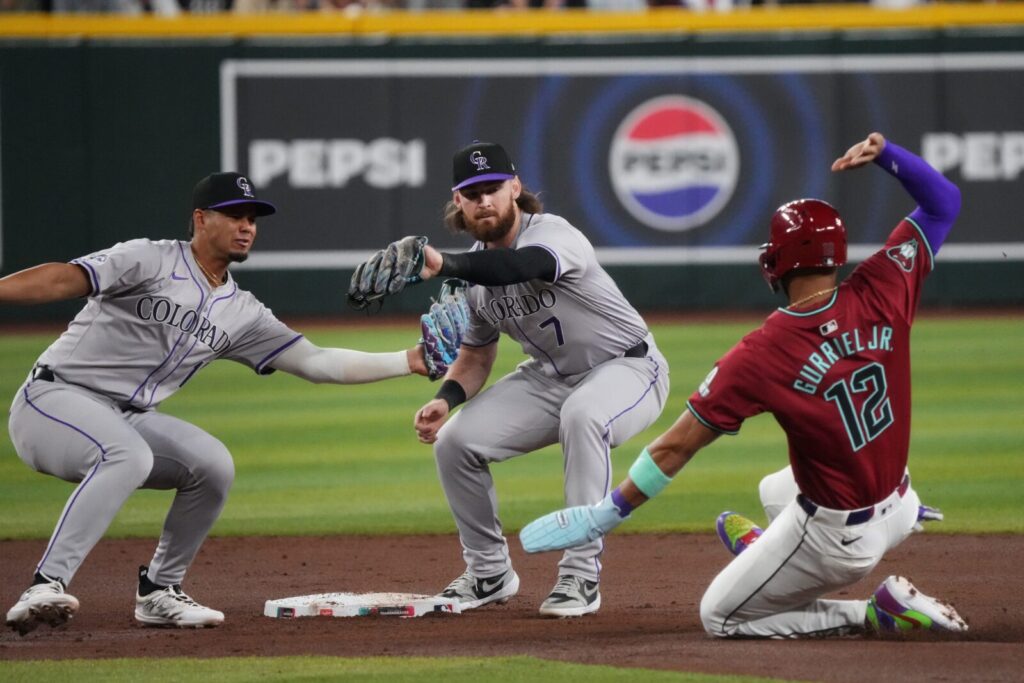Strike 1: If you sat through the months-long third inning of the Colorado Rockies season opening debacle against the Arizona Diamondbacks in Phoenix, you came away wondering why anyone who didn’t pay for a ticket would have sat through that instead of changing the channel (assuming you had access to the game on your TV to begin with).
There was a Cheers rerun on somewhere, right?
The deal is, however, that a lot of people who weren’t in the stands actually did pay money to see it. That’s how watching Major League Baseball in both Phoenix and Denver is working these days. It’s pretty much pay-per-view now. The days of over-the-air and cable TV broadcasts are gone and they aren’t coming back.
This is most certainly an inconvenience at the moment (although if you flip on Direct TV Stream and others, and turn to the same channel that carried the Rockies last season, they’re still on there, in all their purple glory.) In the long run, the plan that MLB has for local TV broadcasts – and revenues – will be welcome news for mid and small market teams like the Rockies and D-Backs.
MLB has taken over production and distribution for both these National League West teams, along with a handful of others including the San Diego Padres. MLB sells streaming subscriptions for both the individual teams and league-wide, eliminating those pesky local blackouts and bringing a nice quality to the broadcast. The downside is a significant dip in revenue for the teams, which is not good news for the Rockies, at least for the time being.
In recent years, local media revenue accounted for just a tick less than one-quarter of each team’s total revenue. That’s more than any of the other major professional sports leagues. The D-Backs were bringing in about $75 million per year before a bankruptcy court let their former broadcast partner, Sinclair, off the hook midway through last season. MLB only guaranteed them about 80% of what Sinclair was slated to pay them in 2023, and didn’t make any promises for 2024 and beyond.
For Arizona, a team whose attendance is significantly impacted by brutal summer heat, that’s a big loss.
The Rockies previous deal with the now defunct AT&T Sportsnet brought them an annual revenue of about $57 million a year. That’s significant as well, and now that they’ve joined Arizona under the MLB umbrella, they can only hope to make 80% of that moving forward.
This could have a significant impact on both team’s payrolls over the next few seasons.
The good news for Rockies fans hoping to see the team improve is that attendance is not a problem in Colorado, and that revenue stream may actually be enhanced when more people who want to see games have to go in person.
But there’s a bigger and under-reported factor in this: Part of MLB’s “ultimate goal” according to reports, is to “centralize” control of local broadcasts, and equally distribute local media dollars, the same way they do with national revenue. This would remove an enormous advantage that teams like the Los Angeles Dodgers – who bring in a reported $334 million per season this way – have over smaller market teams in terms of what teams can spend on players.
Is anyone around here afraid of a little MLB broadcast revenue “socialism” to help level the playing field? I’m sure the Rockies wouldn’t be adverse to sharing the respective TV pies with the Dodgers.
So maybe there’s an upside to the demise of AT&T Sportsnet and the other regional sports networks that fans weren’t aware of? Rest assured that the folks in LA aren’t going to be eager to do this, but maybe down the road the majority will end up ruling in Colorado and Arizona’s favor?

